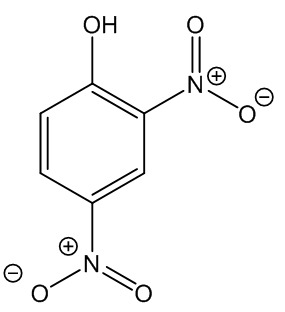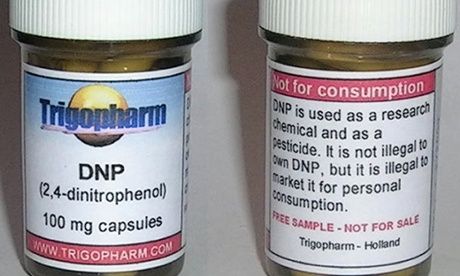 |
2,4-Dinitrophenol (DNP)The weight-loss pill that's potentially fatal
Simon Cotton
Also available: HTML version.
|
 |
2,4-Dinitrophenol (DNP)The weight-loss pill that's potentially fatal
Simon Cotton
Also available: HTML version.
|

2,4-Dinitrophenol
Researchers at Yale University have found evidence that it can reverse type-2 diabetes and fatty liver disease in rats, leading to speculation that it might be useful one day in treating these conditions in humans.
Well, apart from the need for more experiments, let alone the requirement to carry out several stages of trials in humans, 2,4-dinitrophenol (DNP) is a dangerous chemical with a chequered past.
 How is that?
How is that?Like picric acid (2,4 6-trinitrophenol), 2, 4-dinitrophenol is a powerful explosive material:
C6H3(NO2)2OH (s)  3CO (g) + 3C (s) + 2H2O (g) + N2 (g)
3CO (g) + 3C (s) + 2H2O (g) + N2 (g)
During World War I it was sometimes used to fill armour-piercing shells, as a mixture with picric acid (Lyddite), known as Shellite. It was synthesised in a multi-step reaction, starting from benzene:

Using 2,4-DNP as a shell filling was less sensitive than picric acid on its own. Nevertheless, an explosion in a munitions factory at Rainham in Essex in 1916 was attributed to 2,4-dinitrophenol. Like TNT, it was found to be toxic to the munition workers handling it. Many lost weight and some even died; fatalities were regularly observed in French munitions plants making it. It has been widely used as a pesticide and in 2009 eleven workers in a Chinese chemical factory – and 9 of their relatives – contracted DNP poisoning, particularly through absorption though the skin (two died). Their skins turned yellow - or even black in extreme cases, as shown in the photo (right). |
|
During the 1930s, scientists investigated 2,4-dinitrophenol as a possible slimming aid. They found that its use greatly speeded up the body’s metabolism. In 1948, it was discovered that it uncouples oxidative phosphorylation in cells. Normally, the body uses carbohydrates and lipids to produce ATP, Adenosine triphosphate, the "energy currency" of cells. DNP transfers protons across membranes and interferes with the production of ATP. The body’s metabolic rate increases, turning more fat and carbohydrate into energy, consequently more heat is produced as fat is “burned”.
Yes, those 1930s studies established that DNP boosted metabolism by up to 50%, leading to considerable weight loss without dieting. The scientists carrying out these studies (Cutting, Tainter and colleagues at Stanford University) warned of the potential side-effects and the small margin for safety, but firms started selling DNP directly to customers, so people were taking it without medical supervision.
 And?
And?Side-effects were observed, such as formation of cataracts, but a number of people died. Body temperatures of up to 110°F (43.5°C) were recorded in fatal cases. These problems led to the US Food and Drug Administration (FDA) banning its use in humans in 1938.
2,4-DNP went underground for years, but it was again marketed as a “weight-loss without dieting” drug in the 1980s, and the internet has given it a wider circulation, describing it as a 'safe weight-loss drug’. It is anything but that. Extravagant claims were made by people who said that they lost 20 pounds in 12 days by taking it; it was promoted as “the king of the fat-loss drugs”. And of course the health problems and fatalities associated with its use returned. The people marketing it will hedge around with labels saying “not for human consumption”, but obviously consumers do not get the guidance that would be given by their doctor. A 27-year-old woman who wanted to lose weight bought some DNP over the internet; she wanted faster results so she took double the recommended dose. It killed her.
Following a report of a Finnish bodybuilder becoming seriously ill after purchasing DNP capsules from a UK-based website, the UK Food Standards Agency (FSA) investigated DNP, publishing its findings in early 2004. They pointed out that the capsules nominally contained 200 mg of DNP, but in practice the amount varied, with Finnish analysis indicating 380 mg per capsule. The FSA said that it was 'not fit for human consumption'.
Whilst the lethal oral dose is of the order of 1 to 3 grams, American studies indicate that a dose of 2 mg per kg bodyweight could result in harmful effects, this amounting to only 140 mg a day for a 70 kg adult male.
There have been a number of fatalities in the UK attributable to DNP. Most recently, in 2015, Eloise Aimee Parry (photo, right), a 21-year old university student from Shrewsbury died after taking it. It has been reported that she took eight pills instead of the suggested dose of one, in order to get faster results. In 2013, an 18-year-old rugby player named Chris Mapletoft died after taking DNP, whilst in the year before a 28-year-old High Wycombe bodybuilder, Sean Cleathero, died after his temperature rose to 42°C when he consumed DNP at his gym. That same year a 23-year-old Leeds University medical student, Sarah Houston, similarly died after consuming DNP that she’d bought over the internet, and which made headline news in the UK (see the newspaper front page at the top of this article). Geoff, her father, said, “For those who are selling it, if you have any ounce of decency, you must stop.” |
|
Being able to buy a chemical – especially over the internet – does not make it safe. There is no antidote to DNP poisoning. And claims made by someone trying to sell a product should be treated with caution. As the Ancient Romans would say, “Cui bono?” (to whose benefit?).
![]()
![]()